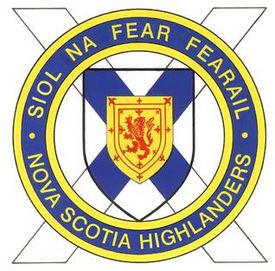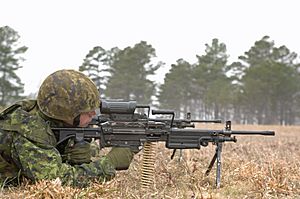Nova Scotia Highlanders facts for kids
Quick facts for kids The Nova Scotia Highlanders |
|
|---|---|

Regimental badge
|
|
| Active | 1871–present |
| Country | Canada |
| Branch | Canadian Army |
| Type | Light infantry |
| Role | Light role |
| Size | One battalion |
| Part of | 36 Canadian Brigade Group |
| Garrison/HQ | Truro, Nova Scotia |
| Nickname(s) | North Novies, North Novas |
| Motto(s) | Scottish Gaelic: Siol na fear fearail, lit. 'Breed of manly men' |
| March | "The Sweet Maid of Glendaruel" (regiment) "The Atholl Highlanders" (1Bn) |
| Engagements | Second Boer War First World War Second World War War in Afghanistan |
| Battle honours | See #Battle honours |
| Insignia | |
| Tartan | MacDonald, Clan Donald |
| Abbreviation | NS Highrs (as seen on rank slip on) Official-NSH |
The Nova Scotia Highlanders (also known as North Novies or North Novas) is a special army unit in Canada. It is part of the Canadian Army's main reserve force. This means its soldiers are ready to serve when needed, but they also have other jobs in their daily lives. The regiment is part of the 36 Canadian Brigade Group, which belongs to the 5th Canadian Division.
Contents
How the Regiment Started
The Nova Scotia Highlanders unit was created in 1954. It was formed by joining together three older army units: The North Nova Scotia Highlanders, The Cape Breton Highlanders, and The Pictou Highlanders. A small artillery unit, the 189th Light Anti Aircraft Battery, Royal Canadian Artillery, also joined them.
At first, the regiment had two main parts, called battalions. The 1st Battalion was based in Truro, with smaller groups in other towns like Amherst and New Glasgow. The 2nd Battalion was based in Sydney.
In 2011, the 2nd Battalion became its own unit again, called the Cape Breton Highlanders. So now, The Nova Scotia Highlanders is a single-battalion regiment.
Special Hats (Headdress)
Soldiers in the Nova Scotia Highlanders wear special hats that show their history. The 2nd Battalion always wore a traditional Scottish hat called a balmoral.
For a while, the 1st Battalion wore a regular army beret. But many soldiers wanted to wear the balmoral again. They felt it showed their unique "Highlander" identity and connected them to their past. Since January 1, 2011, the balmoral is the official hat for the 1st Battalion too. When soldiers are in combat uniform, they wear a khaki tam o' shanter, which is another type of Scottish cap.
Regiment's History (Lineage)
The Nova Scotia Highlanders unit has a long and interesting history, going back to the 1800s. Many different smaller units joined together over the years to form the regiment we know today.
1st Battalion, Nova Scotia Highlanders (North)
This part of the regiment started in Truro, Nova Scotia, in 1871. It changed its name several times over the years, from "Colchester and Hants Provisional Battalion of Infantry" to "The Pictou Highlanders." In 1954, it joined with The North Nova Scotia Highlanders and the 189th Light Anti-Aircraft Battery to become the 1st Battalion of The Nova Scotia Highlanders.
The North Nova Scotia Highlanders
This unit began in Amherst, Nova Scotia, in 1871. It was first called the "Cumberland Provisional Battalion of Infantry." It also changed names many times, eventually becoming "The Cumberland Highlanders." In 1936, it joined with parts of "The Colchester and Hants Regiment" and a machine gun company to become "The North Nova Scotia Highlanders (Machine Gun)." In 1954, it joined with The Pictou Highlanders to form the new Nova Scotia Highlanders regiment.
The Colchester and Hants Regiment
This regiment started in Truro, Nova Scotia, in 1910. It later joined with the "81st 'Hants' Regiment" in 1920. In 1936, most of this unit joined with "The Cumberland Highlanders."
The 81st "Hants" Regiment
This unit began in Windsor, Nova Scotia, in 1914. It joined with the "76th Colchester and Hants Rifles" in 1920.
189th Light Anti-Aircraft Battery, RCA
This small artillery unit started in Stellarton, Nova Scotia, in 1946. It joined with The Pictou Highlanders and The North Nova Scotia Highlanders in 1954.
Honoring Past Units (Perpetuations)
"Perpetuations" means that the Nova Scotia Highlanders keep alive the history and traditions of older units that are no longer active. It's like they carry on the legacy of these past soldiers.
War of 1812
- 1st Battalion, County of Sydney Regiment
- 2nd Battalion, County of Sydney Regiment
- 1st Battalion, Cumberland Regiment
- Parrsborough Corps
The Great War (World War One)
- 17th Battalion (Nova Scotia Highlanders), CEF
- 25th Battalion (Nova Scotia Rifles), CEF
- 106th Battalion (Nova Scotia Rifles), CEF
- 193rd Battalion (Nova Scotia Highlanders), CEF
- 246th Battalion (Nova Scotia Highlanders), CEF
What the Regiment Has Done (Operational History)
South African War
In the late 1800s, soldiers from the 93rd Cumberland Battalion of Infantry volunteered to fight in the South African War.
World War One
When World War One started in 1914, parts of the 76th Colchester and Hants Rifles, the 78th Pictou Regiment "Highlanders," and the 93rd Cumberland Regiment were called to protect local areas.
Several new battalions were formed to fight overseas:
- The 17th Battalion (Nova Scotia Highlanders), CEF went to Great Britain in 1914. It helped provide new soldiers for the Canadian forces.
- The 25th Battalion (Nova Scotia Rifles), CEF went to Great Britain in 1915 and then fought in France starting in 1916. They were part of the 2nd Canadian Division until the war ended.
- The 106th Battalion (Nova Scotia Rifles), CEF went to Great Britain in 1916. Its soldiers later joined other units.
- The 193rd Battalion (Nova Scotia Highlanders), CEF went to Great Britain in 1916. Its soldiers also joined other units to help the Canadian forces.
- The 246th Battalion (Nova Scotia Highlanders), CEF went to Great Britain in 1917, and its soldiers quickly joined other units to help with reinforcements.
The Second World War
Before World War Two officially started for Canada in 1939, parts of The Pictou Highlanders and The North Nova Scotia Highlanders were called to active duty. They helped protect local areas.
Later, full battalions were sent to serve:
- The 1st Battalion, The Pictou Highlanders, served in Newfoundland from 1943, helping defend the home front. One company (a smaller group of soldiers) was sent to the Bahamas for guard duty.
- A special company called the Special Infantry Company (Pictou Highlanders) served in Bermuda from 1942 to 1946, also on guard duty.
- The North Nova Scotia Highlanders formed their own battalion, the 1st Battalion, The North Nova Scotia Highlanders. They went to Great Britain in 1941. On D-Day, June 6, 1944, they landed in Normandy, France, as part of the 3rd Canadian Infantry Division. They fought bravely across North-West Europe until the war ended.
- After the war, a 3rd Battalion was formed in 1945 to serve with the Canadian Army in Germany.
After the Wars (Post-War)
In 1951, the regiment created two temporary companies, "E" and "F."
- "E" Company's soldiers joined the 1st Canadian Highland Battalion. This battalion served in Germany as part of the North Atlantic Treaty Organization (NATO), which is a group of countries that work together for defense.
- "F" Company's soldiers joined the 2nd Canadian Highland Battalion. This battalion served in Korea with the United Nations (UN), an organization that works for world peace.
War In Afghanistan
Between 2002 and 2014, many soldiers from the Nova Scotia Highlanders volunteered to serve in Afghanistan. More than 20% of the regiment's soldiers took part in different missions there.
Battle Honours
Battle honours are special awards given to military units for their bravery and success in important battles or campaigns. The Nova Scotia Highlanders have received 47 battle honours and one special honorary award. The honours listed in small capitals are for large operations, while others are for specific battles.
- War of 1812
- Non-emblazonable honorary distinction Defence of Canada – 1812–1815 – Défense du Canada
- South African War
- South Africa, 1899–1900
- First World War
-
- Ypres, 1915
- Festubert, 1915
- Mount Sorrel
- Somme, 1916
- Flers–Courcelette
- Thiepval
- Ancre Heights
- Arras, 1917
- Vimy, 1917
- Arleux
- Scarpe, 1917
- Hill 70
- Ypres, 1917
- Passchendaele
- Somme, 1918
- Amiens
- Arras, 1918
- Scarpe, 1918
- Hindenburg Line
- Canal du Nord
- Cambrai, 1918
- Pursuit to Mons
- France and Flanders, 1915–18
- Second World War
-
- Normandy Landing
- Authie
- Caen
- The Orne
- Bourguébus Ridge
- Faubourg de Vaucelles
- Verrières Ridge–Tilly-la-Campagne
- Falaise
- The Laison
- Chambois
- Boulogne, 1944
- Calais, 1944
- The Scheldt
- Savojaards Plaat
- Breskens Pocket
- The Rhineland
- Waal Flats
- The Hochwald
- The Rhine
- Zutphen
- Leer
- North-West Europe, 1944–1945
- South-West Asia
- Afghanistan
Armouries
Armouries are buildings where military units train, store equipment, and hold meetings. The Nova Scotia Highlanders use several armouries across Nova Scotia.
| Building Name | Built Year | Special Status | Location | What it's like | Image |
|---|---|---|---|---|---|
| Colonel Welsford MacDonald Armoury | 31 Union Street, Pictou, Nova Scotia | *This building houses The Nova Scotia Highlanders and has a flat roof. | |||
| New Glasgow Armoury | 1940s | 10 Riverside Parkway, New Glasgow, Nova Scotia | *Acquired in the 1960s, this building also houses The Nova Scotia Highlanders. It has a flat roof and will soon be replaced by a new building. | ||
| Colonel James Layton Ralston Armoury | 1914-1915 David Ewart | Canada's Register of Historic Places; Recognized - 1990 Register of the Government of Canada Heritage Buildings | 36 Acadia Street, Amherst, Nova Scotia | **This large, historic building houses The Nova Scotia Highlanders. It is made of stone and brick in a Scottish castle style, with two strong towers and a big entrance. | |
| Lieutenant Colonel Daniel J Murray Armoury | 72 North Street, Springhill, Nova Scotia | *This building houses The Nova Scotia Highlanders and has a flat roof. | |||
| Truro Armoury | 1874 Thomas Seaton Scott | Canada's Register of Historic Places; Recognized - 1991 Register of the Government of Canada Heritage Buildings | 126 Willow Street, Truro, Nova Scotia | *This building houses the 1st Battalion, The Nova Scotia Highlanders. It has a flat roof and was designed with a classic, old-style look. |
Images for kids
See Also
- Canadian-Scottish regiment
- West Nova Scotia Regiment
- List of armouries in Canada
- Military history of Nova Scotia
- Military history of Canada
- History of the Canadian Army
- Canadian Forces
Media
- No Retreating Footsteps: The Story of the North Novas by Will R. Bird (1955)
- The Fighting North Novies: Into the Fire by Al Cameron
- Eighty-Fifth in France and Flanders Being a history of the justly famous 85th Canadian Infantry Battalion (Nova Scotia Highlanders) Jan 1 1920 by Lt-Col Joseph Hayes (Author)
- North Nova Scotia Highlanders by D.F. Forbes (1945)
Order of Precedence
| Preceded by The North Shore (New Brunswick) Regiment |
The Nova Scotia Highlanders | Succeeded by Le Régiment de Maisonneuve |



